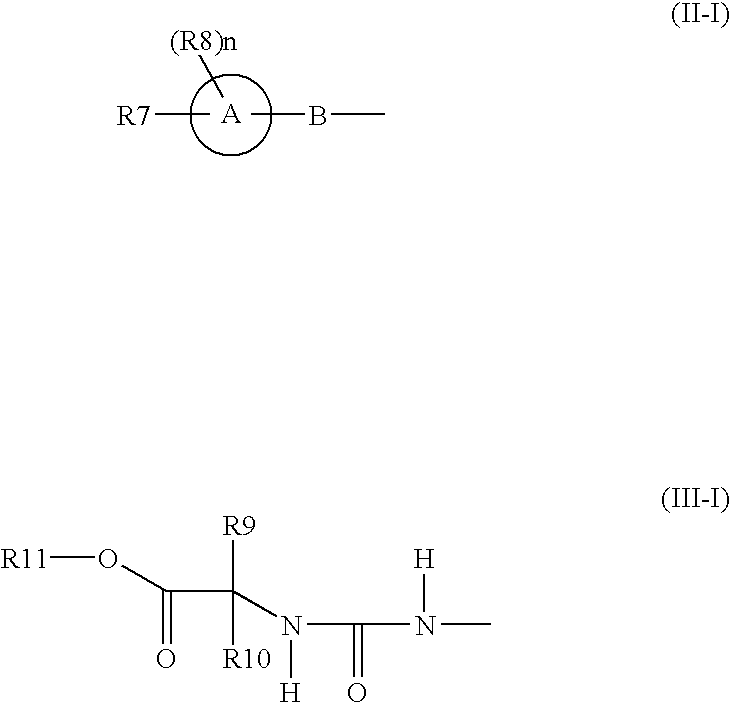Benzene compounds
a technology of benzene compounds and compounds, applied in the field of benzene compounds, can solve the problems of increasing peripheral vascular resistance, hypertensive symptoms, and impaired glucose tolerance, and achieve excellent acc inhibiting activity, prevent, treat, and arrest the development of these diseases, good solubility and internal dynamics
- Summary
- Abstract
- Description
- Claims
- Application Information
AI Technical Summary
Benefits of technology
Problems solved by technology
Method used
Image
Examples
embodiment 1-i
Synthesis of Compound 1-I
[0306] 4.0 g of commercial Wang resin (about 1.0 mmole / g) was suspended in NMP and left standing for three hours at room temperature. The excess solvent was removed. A 60 mL of NMP, 3.2 g of 4-nitrobenzoic acid, 2.9 mL of pyridine, and 3 mL of 2,6-dichlorobenzoyl chloride were added and the mixture was stirred for 20 hours at room temperature. The solvent was removed and the resin was washed twice with 60 mL of N-methylpyrrolidone (NMP hereinafter). The solvent was removed and the resin was sequentially washed three times each with 60 mL each of dichloromethane, NMP, and dichloromethane, and the resin was dried.
[0307] To the obtained resin were added 6 g of stannous chloride, 60 mL of NMP, and 3 mL of ethanol, and the mixture was stirred for 12 hours at room temperature. The solvent was removed and the resin was washed twice with 60 mL of NMP. The solvent was removed; the resin was sequentially washed three times each with 60 mL each of dichloromethane, NM...
embodiment 2-i
Synthesis of Compound 2-I
[0311] Compound 1-I obtained in Embodiment 1-I was dissolved in 10 mL of tetrahydrofuran and 10 mL of methanol, an excess quantity of 2N sodium hydroxide aqueous solution was added, and the mixture was stirred for 17 hours at room temperature. When the reaction had ended, the solution was acidified with 1N hydrochloric acid aqueous solution, and the methanol was removed. The residue was diluted with ethyl acetate and sequentially washed with 1N hydrochloric acid aqueous solution and saturated brine. Following drying with anhydrous sodium sulfate, the solvent was removed under reduced pressure. The residue was purified by recrystallization, yielding embodiment compound 2-I.
embodiment 3-i
Synthesis of Compound 3-1
[0312] 4.0 g of commercial Wang resin (about 10 mmole / g) was suspended in NMP and left standing for three hours at room temperature. The excess solvent was removed and 60 mL of NMP; 3.2 g of 4-nitrobenzoic acid, 2.9 mL of pyridine, and 3 mL of 2,6-dichlorobenzoyl chloride were added; and the mixture was stirred for 20 hours at room temperature. The solvent was removed and the resin was washed twice with 60 mL of NMP. The solvent was removed, the resin was sequentially washed three times each with 60 mL each of dichloromethane, NMP, and dichloromethane, and the resin was dried.
[0313] Next, 6 g of stannous chloride, 60 mL of NMP, and 3 mL of ethanol were added to the obtained resin and the mixture was stirred for 12 hours at room temperature. The solvent was removed and the resin was washed twice with 60 mL of NMP. The solvent was removed, the resin was sequentially washed three times each with 60 mL each of dichloromethane, NMP, and dichloromethane, and the...
PUM
| Property | Measurement | Unit |
|---|---|---|
| pH | aaaaa | aaaaa |
| temperature | aaaaa | aaaaa |
| temperature | aaaaa | aaaaa |
Abstract
Description
Claims
Application Information
 Login to View More
Login to View More - R&D
- Intellectual Property
- Life Sciences
- Materials
- Tech Scout
- Unparalleled Data Quality
- Higher Quality Content
- 60% Fewer Hallucinations
Browse by: Latest US Patents, China's latest patents, Technical Efficacy Thesaurus, Application Domain, Technology Topic, Popular Technical Reports.
© 2025 PatSnap. All rights reserved.Legal|Privacy policy|Modern Slavery Act Transparency Statement|Sitemap|About US| Contact US: help@patsnap.com



